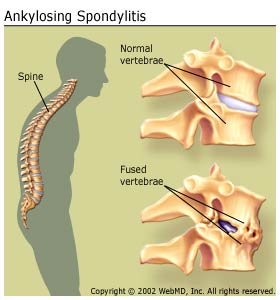Ankylosing spondylitis is a chronic inflammation of the spine and sacroiliac joints that can result to a hunched-forward posture. The ailment is characterized by a less flexible spine due to some vertebrae mingling together. In serious cases, this condition can make it impossible for the patient to lift his head enough to see forward because of the extreme pain and inflammation.
The signs and symptoms of the condition often become apparent during early adulthood.There is no cure for ankylosing spondylitis. Instead, treatment focuses on making the pain more bearable. Ankylosing spondylitis is considered by experts as a systemic disease that can cause disturbance to other tissues in the body. As such, the symptoms of this disease can affect the joint between the base of the pelvis and spine; vertebrae in the lower back, and the cartilage between the breast bone and ribs. It can also appear in places where ligaments and tendons attach to the bones as well as the joints of the hips and shoulders. Likewise, other organs like the heart, lungs, eyes and kidneys can also be affected by this condition. In a way, ankylosing spondylitis can be mistaken for other arthritic conditions like psoriatic arthritis and reactive arthritis because it shares many features with these types of arthritis.
Symptoms
 The most common symptom of this condition is pain that is felt in the lower back, neck, and other parts of the spine. At first, the pain is bearable until it worsens to the point that there is loss of range of motion that can be noticed in just a matter of months. In some cases, the onset of pain is quick and intense. The pain is usually worse in the morning, and only eases after taking a warm shower. Since the symptoms of this disease frequently appear during the adolescence stage, sufferers often mistake the ache as a result of athletic injuries.
The most common symptom of this condition is pain that is felt in the lower back, neck, and other parts of the spine. At first, the pain is bearable until it worsens to the point that there is loss of range of motion that can be noticed in just a matter of months. In some cases, the onset of pain is quick and intense. The pain is usually worse in the morning, and only eases after taking a warm shower. Since the symptoms of this disease frequently appear during the adolescence stage, sufferers often mistake the ache as a result of athletic injuries.
When To Seek Medical Help
People who can no longer bear the chronic hurt and stiffness felt in the lower back and hips should immediately seek medical attention. The same is true for those whose heavy breathing makes their chest hurt, or notice light sensitivity, blurred vision and eye pain.
Treatment
One of the many drugs prescribed for controlling the symptoms of ankylosing spondylitis is Humira (adalimumab). This is a TNF inhibitor that is also prescribed for other arthritic conditions like rheumatoid arthritis, Crohn’s disease and psoriatic arthritis. Humira relieves pain and lessens the inflammation caused by ankylosing spondylitis. In 2008, one clinical study showed that Humira can lessen the signs and symptoms of the condition for up to three years in nearly 3 out of four patients suffering from ankylosing spondylitis. Like other TNF inhibitors, Humira binds to Necrosis Factor Alpha which contributes to inflammation in autoimmune diseases. When this happens, Humira is able to block the anti-inflammatory effects of Necrosis Factor Alpha which results to lessening the pain and inflammation of people with ankylosing spondylitis. Humira is administered through injections. It is available in .8ML syringes and pens.
Share This